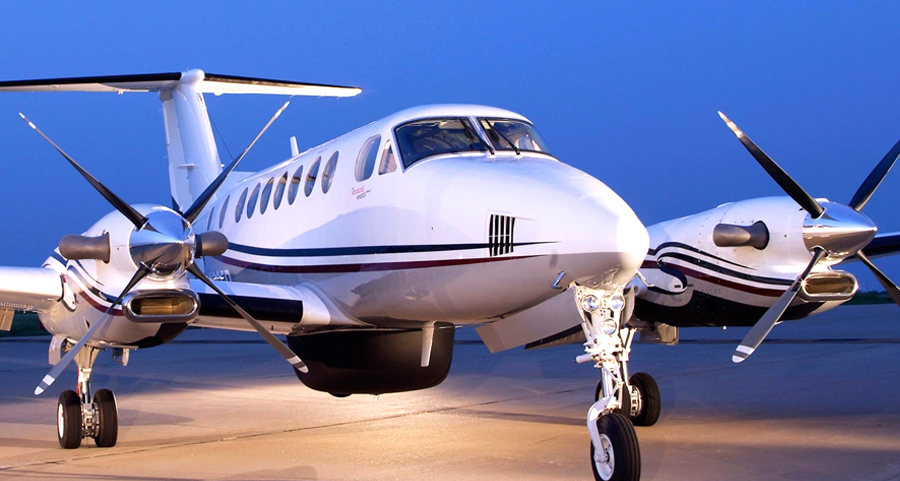A Brief History of the King Air
Chariot in the Sky
In 1905 on a farm near Pulaski, Tennessee, a 14-year-old boy built and flew a glider of his own design for the first time. That boy was Walter H. Beech, the founder of Beechcraft Corporation (formerly Beech Aircraft), a company that would later produce the most popular turboprop utility aircraft in the world: The King Air. Fashioned from the rib of the Queen Air (a modified Twin Bonanza with a larger fuselage and new tail) the Queen Air served as the usher in design for the highly developed, globally successful King Air series. Conception of the King Air began in 1961, In May of 1963 test flights of the modified Queen Air, Model 87, began.

Fitted with Pratt and Whitney PT6A engines which are light, durable, and easy to maintain, Olive Ann Beech (who took over as president after Walter’s death in 1950) publicly announced the Model 87 and began taking orders for the “King Air” the very next month. Since then, approximately 7,600 King Airs have been delivered all over the world and logged over 63 million flight hours.
The history of the King Air is inextricably tied to the history of the Pratt & Whitney PT6 engine. With one exception (the Model B100 powered by the AirResearch TPE-331) EVERY King Air model made for the civilian or military market has been powered by PT6 engines.
From the beginning, the King Air’s performance speaks for itself. It continues to hold a lengthy reputation for being innovative and versatile as well as durable and reliable. These attributes have ensured a great deal of trust from a loyal following that shows no signs of decline. A surprising feature that has attracted fans and users of the King Air is the cabin itself, which is notably more comfortable than its competitors; most of whom have come and gone. Now owned by Textron Aviation, regional sales director for Textron Canada, Leon Munyon, calls the King Air “The SUV of our product line.” The turboprops capability for load capacity accounts for weight and balance issues, which is just one of the reasons the King Air continues to be a popular choice.
Textron further progressed the luxury of the cabin with seats and cabinetry that rival that of a mid-size jet.
Enthusiasts will also be attracted to the King Air’s customizable interior, enhanced digital pressurization system for increased passenger comfort, cutting edge touchscreen avionics technology, and seats that laterally track, recline, and swivel.
Standard Features Included in the King Air Aircraft:
- Automatic Flight Guidance System (AFGS)
- Collins Aerospace Pro Line Fusion Avionics Suite
- Graphical Flight Planning
- Integrated Maps
- Synthetic Vision
- Three 14-Inch Touchscreen Displays
- Digital Pressurization Indication
- Dual Flight Management Systems (FMS)
- Dual Navigation and Communication Radios
- Engine Indicating and Crew Alerting System (EICAS)
- Integrated Terrain Awareness and Warning System (ITAWS)
- IS&S (Innovative Systems & Support) ThrustSense Autothrottle
- Multi Scan Weather Radar System (WXR)
- Traffic Alert and Collision Avoidance (TCAS II)
Since its maiden voyage, the King Air has proven worthy not only for private and corporate use, but also as military and medical aircraft, with unparalleled capabilities when configured with air ambulance equipment. Capable of landing at smaller airports, shorter runways, and even on grass, King Air shows versatility that many other aircraft cannot.
The most notable users of the King Air aircraft are the U.S. Navy, the Japanese Military, and the Royal Flying Doctors in Australia. The military designation model VC-6A was used to transport President Lyndon Johnson, a flight during which the aircraft used the callsign Air Force One. Since the first test flight of the “Proof-of-concept” Model 87, the development of the King Air has advanced through several variants, typically divided into two classes - the King Air 90 Series, and the King Air 100 Series.
Chronologically the variants are as follows:
BEECHCRAFT DESIGNATIONS
- Model 87
- Model 65-90
- Model 65-A90
- Model 65-A90-1 (Based on Model 87, 141 delivered to the US Army.)
- Model 65-A90-2 (Specialized electronic warfare variant.)
- Model 65-A90-3
- Model 65-A90-4 (Project Guardrail variant.)
- Model B90
- Model C90
- Model C90-1
- Model C90A (Two Pratt & Whitney PT6A-21 reverse-flow, free-turbine engines.)
- C90B and C90SE
- Model C90GT
- Model C90GTi (C90GT variant with “glass cockpit”.)
- Model C90GTx
- Model D90 (One prototype abandoned.)
- Model E90
- Model F90 (C90 with T-tail.)
- Model F901
- Model G90
- Model H90 (C90 modified as pilot trainer for the United States Navy.)
- Model 100
- Model A100
- Model A100-1
- Model A100A
- Model A100C
- Model B100
- Model C100
MILITARY DESIGNATIONS
- YU-21
- U-21A Ute (Utility aircraft for US Army with fuselage of Queen Air 65-80 and wings of King Air 65-90)
- EU-21A (Radio relay aircraft used over Vietnam.)
- JU-21A (Configured with Left Jab Signals Intelligence System. One aircraft with callsign “Vanguard 216” was shot down by a Surface to Air Missile on March 4, 1971.)
- RU-21A
- RU-21B
- RU-21C
- RU-21D (Deployed to Vietnam.)
- RU-21E
- U-21F
- U-21G Ute
- RU-21G
- RU-21H
- U-21H Ute
- JU-21H
- VC-6A
- T-44A Pegasus (Multi-engine training aircraft for US Navy.)
- T-44C Pegasus (T-44A upgraded with Rockwell Collins Pro Line 21 series avionics suite technology.)
There are almost 4,000 King Airs actively flying in the United States, which is just one of 130 countries that still consider it to be one of the most trusted and reliable brands. The King Air C90GTx, King Air 250, and King Air 350i remained in production until 2021. The latest King Air model, the 350i, is the most fuel-efficient aircraft in the business aviation market. Although Textron Aviation confirmed the end of production for the King Air, one thing is for sure: the Beechcraft King Air has a legacy that will no doubt live on in memory as one of the most triumphant rulers of the sky in aviation history.
Sources:
Thanks to the following for contributions to this article:
https://en.wikipedia.org/wiki/Beechcraft_King_Air
https://txtav.com/en/journey/articles/articles/king-air-a-history
https://kingairnation.com/blog/tag/General+News
https://skiesmag.com/features/king-air-popular-choice-aircraft-operators/
Photo courtesy of:
https://www.aircharterservice.com/aircraft-guide/private/hawkerbeechcraftcorp-usa/beechcraftkingair350350i
